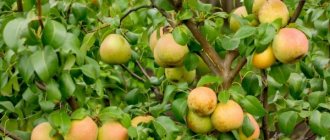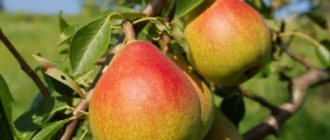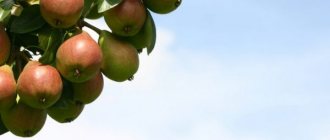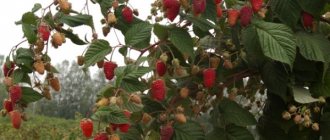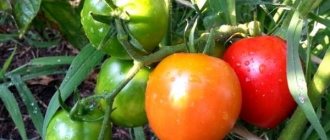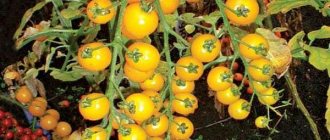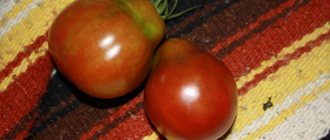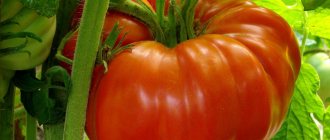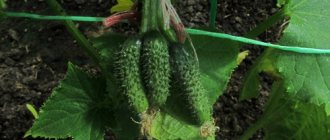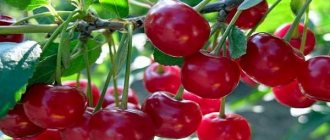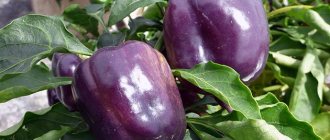Pears are one of the favorite fruit trees of almost all gardeners. The varietal diversity is simply amazing. Bergamot is one of the favorite varieties due to the excellent taste of the fruit and its many subspecies.
The fruits of this variety are distinguished by their slightly flattened shape. Summer residents love Bergamot for its adaptability to different growing conditions and its high resistance to changes in temperature and humidity.
Varieties of pear
Gardeners' preferences can be roughly determined by region. In the southern regions, Autumn Bergamot is more often grown. In the west they like to plant Bergamot Moscow and In Memory of Prince Trubetskoy.
Bergamot Moscow
Trees of this variety form a neat crown with an average volume of foliage. The pear grows of medium height and tends to produce numerous shoots. The elongated oval leaves are medium in size and have jagged edges.
Flattened, round pears with a greenish tint (as in the photo) have a pleasant taste. The pulp is juicy, medium density. The sweetness of the fruit is softened by a slight sourness. If the fruits of this variety are stored for a long time, the taste acquires astringent properties and the sourness increases.
The Bergamot Moscow variety produces its first decent harvest after 4 years, and approximately 20 kg of fruit is collected from one trunk.
Bergamot Autumn
The variety has been popular among gardeners for a very long time. The trees grow of medium height, the crown is formed of a pyramidal type and has short and thick, slightly pubescent branches. The shape of the leaves is oblong and pointed. Ripe fruits of the Bergamot Autumn variety reach a weight of 80 g and have loose pulp; they can be stored for about three weeks. Frost resistance is one of the important advantages of the Osenniy variety.
Attention! This variety of pears begins to bear fruit after seven to eight years.
The fruits of this variety ripen with a medium round shape (photo). The skin of the pear is yellowish-green in color, with small dots. On the sunny side of the fruit, blush may appear. The pulp has a loose consistency and a sweetish wine taste.
Negative qualities of this Bergamot variety: susceptibility to disease (most often affected by scab), low yield. Therefore, there are unflattering reviews about the variety.
Bergamot Nutmeg
Features of this pear variety: trees with thick branches grow quite tall, and the crown can be about 12 m in diameter. Bergamot Muscat is a prolific variety; approximately 250 kg of fruit can be harvested per season. It is noteworthy that this variety of pears bears fruit well even at 60 years of age.
The fruits begin to sing in August; the fruits are yellowish in color with speckles and grow oblong in shape. The juicy, creamy flesh has a pleasant taste.
Warning! The disadvantages of the Bergamot Muscat variety include the rapid overripening of pears and special attention from wasps (often the fruits are simply eaten away by insects).
Bergamot In Memory of Prince Trubetskoy
The tree is characterized by the formation of a dense crown. The leaves grow oblong in shape. Four-year-old trees already produce a good harvest, and the pear bears fruit annually or every other season.
The broadly pear-shaped fruits stand out in greenish-yellow hues. They are distinguished by juicy, medium-density pulp. The fruits of the Bergamot variety can weigh approximately 190 g and are perfectly stored until spring if appropriate conditions are met.
A distinctive feature of this pear variety is its unpretentiousness and resistance to diseases (especially fungal ones). This Bergamot variety takes root well in any soil and develops well in different weather conditions. Very resistant to frost. The harvest begins to ripen in September.
Types of "Bergamot"
In Russia and the CIS today, 6 varieties of this variety are actively cultivated; below you will find a brief description of each of them:
- Variety "Novik".
- Autumn "Bergamot".
- Volzhsky.
- Moscow.
- Dagestan.
- Rossoshansky.
Autumn pear variety "Bergamot"
This variety was bred by the famous biologist-breeder Ivan Michurin. The strong tree can reach 15 meters in height. It blooms at the end of spring, and the fruits ripen in late August. The Novik pear is medium-sized, the weight of one fruit is 90-100 grams. The skin color is yellow. The fruits have a lot of juice, the flesh is dense, white-cream. New harvest fruits are rarely stored longer than 10 days. The peculiarity of this selection is annual abundant fruiting and good frost tolerance.
Autumn "Bergamot"
A large plant, similar in appearance to the Novik variety. The characteristics of the two selections are almost identical. The only difference is the color and taste of the fruit. Ripe pears are yellow-green in color and have soft flesh. Autumn is a productive variety, bears fruit every year and abundantly. The pear can be stored for no more than 7 days.
Volga "Bergamot" ripens in early September. Ripe fruits attract attention with their presentation - they are larger than average in size, green with a bright side. Pears taste sweet, juicy, and their flesh is soft. They are stored longer than other selections - 20-25 days after harvest.
Moscow
Gardeners love the Moscow variety. The trees of this selection are medium-sized, with a rounded and moderately dense crown. The fruits of the “Moscow” variety ripen in early September. They are stored for no more than two weeks, but can last up to two months in the refrigerator. The advantage of the “Moskovsky” variety is its presentable appearance and good taste of the fruit. Ripe wilderness weighs 150-160 grams, it is round in shape, beautiful yellow in color. The pulp of the fruit is dense and contains a lot of juice. The taste is balanced between acidity and sweetness.
The fruits of the “Moscow” species ripen in early September
Dagestan
Breeders developed this hybrid several years ago. It is classified as a winter selection, the fruits ripen in early October. Fruit trees are strong and tall, reaching a height of 15 meters. The shape of the crown is round and dense. The fruits are large, the average weight of a pear is 130 grams. The skin color is yellow with a slight tint of green.
The pear tastes sweet and sour, the pulp contains a lot of juice. The fruits cannot be eaten immediately after harvesting; they must ripen within 2-3 weeks. Ripe fruits are stored for 3-3.5 months.
Rossoshansky
The “Rossoshansky” selection, like “Moskovsky” and “Novik”, is an autumn selection. The fruits ripen in early September and are stored after harvest for 3.5 weeks. The plant begins to bear fruit in the fifth year after planting, the yield is average - 50-60 kg of fruit per tree. The fruits are not large - the average weight of a pear is 80 grams. The color is green-yellow, with a slight blush on the side. The pulp of Rossoshansky is not very juicy, but soft. The advantage of the species is high frost resistance and immunity to diseases.
How to care for Bergamot?
"Bergamot" is unpretentious in care, but there are several rules, the observance of which will increase the yield and prolong the life of the fruit tree:
- It is advisable to plant seedlings in areas protected from the wind and away from groundwater. The pear of this selection does not like a lot of moisture.
- Before planting the plant in the ground, soak the roots in water for several hours.
- Water the plant regularly, but not abundantly.
- Before frost, insulate the roots and branches to prevent the tree from dying.
- Every year, trim the crown and excess shoots and fertilize the plant.
As you can see, care is no different from caring for other garden crops.
Planting seedlings
When choosing a place to plant Bergamot pears, you should give preference to elevated, well-lit areas. Loams or chernozems are preferable among soils.
Advice! In the southern regions, it is better to plant the Bergamot variety in the fall (in the summer it will be difficult for the pear to survive in hot weather), and in the northern regions - in the spring (otherwise it will be difficult for the seedling to take root in the frosty winter).
Planting stages
- The hole for the seedling is prepared in advance. The parameters are selected for its root system, but are at least 40-50 cm in depth and 70-85 cm in diameter.
- To pre-fertilize the soil, a hole is dug a little deeper and 2-3 buckets of fertile soil are poured onto the bottom (the soil is mixed with peat, humus, you can add superphosphate and ash).
- A peg must be driven into the center to tie the trunk. Otherwise, the Bergamot pear may become deformed.
- The seedling is placed in the hole, the roots are carefully straightened and the hole is filled up. At this stage, it is important to avoid excessive deepening so that the root collar does not become buried.
The right time for planting Bergamot pears is: in the spring - the last days of April, and in the fall - until October 15.
Tree pruning
A similar operation is carried out in order to regulate the growth and illumination of the crown, eliminate old and dried branches, and increase productivity.
Advice! The operation is carried out at an air temperature not lower than + 5˚ C.
There are two methods for pruning Bergamot pears.
- Branch trimming involves cutting off the top parts of branches and annual growths. Thanks to this method, the “pulling” of the tree upward is stopped and the horizontal growth of branches is stimulated.
- Thinning is intended to remove growth branches at their very base. Thanks to this method, it is easier for sunlight to enter the crown and improves air exchange. These measures lead to an increase in the protective properties of the Bergamot pear variety and an increase in its yield.
For pruning in spring, a period is selected when severe frosts have ended, but the growing season has not yet begun. The main goal is to remove branches growing inside the crown.
The top of one-year-old seedlings is shortened so that in the future the crown of Bergamot does not darken and the lower branches grow.
The next season, the skeleton of the crown is already formed: the central conductor is cut to a quarter of its length.
When pruning young Bergamot pears, you should not get carried away, as this can lead to later fruiting.
In old pears, the shoots are shortened by half or two-thirds of their length. Thanks to this, the trees rejuvenate.
Watering and fertilizing
The Bergamot variety is quite tolerant of dry periods. Depending on the region, watering requirements may vary.
But seedlings especially need soil moisture in the first years. Therefore, during dry periods, it is recommended to water the Bergamot pear 3-4 times per season at the rate of two to three buckets for each tree.
In subsequent years, the number of irrigations is reduced, but the volume increases (about one and a half to two times).
Important! It is advisable to carry out the first watering at the moment the ovary begins to grow, and the rest should be done towards the end of summer.
The basic rule of watering: do not pour water on the root collar. It is best to form a ring groove around the Bergamot pear. The roots should not be exposed, but if this happens, the roots should be covered with moist soil. It is believed that with full watering, the soil should be moistened to the depth of the active roots - this is approximately 55-65 cm.
When moistening, the composition of the soil must be taken into account: on sandy soils, pears are watered in small portions, but often. And for heavy clay soils, rare but abundant watering is recommended.
Advice! Final watering is carried out in late autumn, almost during leaf fall. It is also called moisture recharging.
In early spring, Bergamot pears are fertilized to ensure a high-quality and abundant harvest. It is recommended to use nitrogen fertilizers; they are added to the soil when loosening.
In the autumn, potassium and phosphorus additives form the basis of fertilizing. They are introduced into the soil to a depth of approximately 40-50 cm in a circle around a Bergamot pear.
Preparing pears for wintering
Preparatory work usually begins with cleaning the area around the tree. Fallen leaves and carrion from branches are collected, and dried fruits are removed. Old mulch is also removed. It is advisable to burn all this garbage.
Dried and diseased branches are removed from the tree. The entire crown and trunk are sprayed from scab. You can use a 5% urea solution for this. Growths are also removed from the trunk.
Important! If wounds appear on the Bergamot pear in the summer, they are cleaned to healthy tissue, then washed with a solution of copper sulfate and covered with garden varnish.
To protect the Bergamot trunk from rodents (hares, mice), the tree is wrapped with protective material. For these purposes, ordinary burlap and spruce wood are suitable.
Reviews from gardeners
Natali_R, Moscow
My Muscovite was perfectly pollinated by the old Bergamot pear, but it is not known at all who pollinated Bergamot before Moskvichka, since there were no pears for 10 houses in the area.
Source: www.forumhouse.ru
Nikolay, Chernigov
According to your characteristics, the pear is similar to my Bergamot. The tree itself is low-growing. The tree is over 15 years old. Fruits every year.
Source: www.sadiba.com.ua
Diseases and pests
The condition of the tree must be monitored throughout the season. There are several most common diseases.
Scab affects almost the entire tree (foliage, fruits, shoots, flowers). The disease appears in the form of brown spots. Favorable conditions for its occurrence are prolonged rains and low temperatures. The close proximity of other Bergamot pears also contributes to the spread of diseases. The main preventive measures are spring spraying of pears with Bordeaux mixture and 7% urea solution. Moreover, it is necessary to treat not only the tree, but also the soil around the trunk. In autumn, all fallen leaves are carefully collected and burned.
Powdery mildew is a fungal disease that affects the leaves of young shoots. The disease leads to leaf loss. Warm, dry weather contributes to the spread of the disease. And, accordingly, control measures include regular watering and removal of damaged branches. Chemical agents include spraying the crown with a solution of colloidal sulfur.
Green aphids are considered the main pest of Bergamot pears. The insect sucks the juice from the leaves, which helps stop the development of shoots. As a means of control, special preparations are used that are sprayed on trees. Moreover, it is advisable to carry out the procedure three times: on the eve of leaf buds blooming (Kinmiks is used), before flowering (Agravertin is used) and when the ovary appears (the tree is treated with Iskra).
The Bergamot pear can be considered a real decoration of gardens. This variety is common in Europe and the CIS countries. This well-deserved popularity is explained by the unpretentiousness and high yield of the variety.
Bergamot Moscow
The improved Moscow Bergamot was developed by a group of scientists led by S.T. Chizhov on the basis of the Moscow Agricultural Academy named after. K.A. Timiryazev. It was zoned for the Central region. The fruits are medium or large, about 150 grams. Their flesh is dense and juicy, and the skin is yellow-green with a pinkish blush. The taste is pleasant, sweet with sourness. Pears ripen in the first ten days of September and are stored for a short time, until the end of the month. Can be stored in refrigerated storage for up to 60 days. The yield is low, about 20 kg per tree. The fruits can not only be eaten fresh, but also prepared into compotes, jams and juices.
Trees of medium height, with a compact crown. The form is self-fertile, but when planted together with the Marble or Naryadnaya Efimova varieties, the yield increases due to cross-pollination. Fruiting occurs in the 4th year. Frost resistance and resistance to scab and other major fungal diseases are high. Bergamot Moscow is also not without its drawbacks. Like his brother, he loves moist soils. During dry seasons, the quality of pears deteriorates greatly, they become coarser, and astringency appears in the taste.
